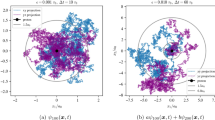Summary
This study is based on relativity and Maxwell’s and Dirao’s equations, without any amendments or added hypothesis. Dirac’s electron equations are used in a tensor form mathematically identical with Whittaker’s but showing more clearly their relation to certain real oscillating vectors, suggested by Kramers. Those vectors are evaluated for various Coulomb-bound states, and in each state the spin, about the preferred axis, corresponds to a rotation of the vectors in physical space. The orbital angular momentum is represented by phase gradients, which vanish in theS states. Corresponding to the concept that neither the spin, nor the orbital, angular momentum is a constant of the motion, it is found that the vectors do not rotate precisely in a plane normal to the preferred axis, and their magnitudes are somewhat dependent on time. In many states the vectorpattern is precisely fixed, in a rotating co-ordinate system. Two of the oscillating vectors are analogous to electric and magnetic polarizations, but if they are polarizations they would apparently emit radiation even in the hydrogen atom ground state. However, the vector analogous to magnetic current density almost vanishes, and the possibility is suggested that the known « virtual » radiative effect causes it to vanish completely. It is shown that if the magnetic current vanishes everywhere, curlA vanishes in free space so no radiation can be emitted.
Riassunto
Questo studio è basato sulla relatività e sulle equazioni di Maxwell e di Dirac, senza correzioni o ipotesi supplementarri Si usano le equazioni dell’elettrone di Dirac in una forma tensoriale matematicamente identica a quella di Whittaker ma che mostra più. chiaramente la loro relazione con alcuni vettori oscillanti, suggeriti da Kramers. Si valutano questi vettori per vari statilegatiper effetto coulombianc, ed in ciascuno stato lo spin, attorno all’asse preferenziale, corrisponde ad una rotazione dei vettori nello spazio flsico. Il momento angolare orbitale è rappresentato da gradienti di fase, che si annullano negli statiS. In corrispondenza al concetto die né lo spin, né il momento angolare orbitale sono costanti del moto, si trova che i vettori non rotano esattamente in un piano normale all’asse preferenziale, e chè le loro grandezze sono in certo modo dipendenti dal tempo. In molti stati la disposizione dei vettori è esattamente fissata in un sistema di coordinate rotanti. Due dei vettori oscillanti sono analoghi alle polarizzazioni elettrica e magnetica, ma se essi fossero polarizzazioni essi emetterebbero apparentemente radiazione anche nello stato fondamentale dell’atomo d’idrogeno. Comunque il vettore analogo alla densità di corrente magnetica quasi si annulla e si suggerisce la possibilità che il noto effetto radiativo « virtuale » faccia in modo che esso si annulli completamente. Si dimostra che se la corrente magnetica si annulla dovunque, rotA si annulla nello spazio libero cosicché non può essere emessa radiazione.
Similar content being viewed by others
References
E. T. Whittaker:Proc. Roy. Soc. (London), A158, 38 (1937).
H. S. Ruse:Proc. Roy. Soc. (Edinburgh),57, 97 (1937).
H. A. Kramers:Quantum Mechanics (Amsterdam, 1958, trans, of 1938 German ed.), p. 258, 271.
Gr. A. Perkins:Suppl. Nuovo Cimento 2, 276 (1964).
Gr. H. Goedecke:Phys. Rev.,135, B 281 (1964).
L. de Broglie:Introduction to the Vigier Theory of Elementary Particles (New York, 1963), p. 42.
E. Durand:Journ. Phys. Radium,16, 262 (1955);Compt. Rend.,239, 751 (1954).
J. A. Steatton:Electromagnetic Theory (New York, 1941), p. 430.
H. A. Bethe andE. E. Salpeter:Quantum Mechanics of One- and Two-Electron Atoms (New York, 1957), p. 64.
Author information
Authors and Affiliations
Rights and permissions
About this article
Cite this article
Perkins, G.A. Oscillating real vectors in Coulomb-bound electron fields. Nuovo Cim 38, 1006–1020 (1965). https://doi.org/10.1007/BF02748612
Received:
Published:
Issue Date:
DOI: https://doi.org/10.1007/BF02748612




